How To Draw Simple Human Figures
5 Ways to Showtime a Figure Cartoon
Drawing Figures:
 Cartoon by Paul Beaudry
Cartoon by Paul Beaudry
One of the challenges of drawing figures is that information technology is a problem solving action that requires the states to be flexible in our approach.
Because no two drawing scenarios are the same, we must learn to creatively think of various solutions to solve each individual "drawing trouble".
When working from life, nosotros besides face the added challenge of having to do thischop-chop, every bit we rarely have unlimited time with the model.
With practise you will acquire to generate as many solutions as in that location are poses. Yous will begin to identify the most important elements in a pose, and recognize which to outset with that will let the rest of the drawing to progress efficiently and smoothly.
For case, if the line of the shoulders is very prominent, you may cull to begin your drawing in that location. Peradventure there is a dynamic move essential to the gesture of the pose that you start with. Very complicated poses can be simplified past beginning with an "envelope" to indicate the surface area that the figure occupies, as well as the major angles of the pose. These are but a few examples of the possibilities.
At that place is usually more than one right reply. Afterwards all, cartoon figures is not solely an analytical activity, but an interpretive and intuitive 1 also. However, within the myriad of possible correct answers, there may be a virtually efficient and constructive way of outset a drawing, which will become easier to place with do.
Let's look at five strategies to "solve" the beginning of a figure drawing.
![]()
Download a PDF version of this article!
(plus, get a weekly newsletter and admission the Members-Only Drawing Resource Library)!
5 Ways to Start Drawing Figures
one. You can begin drawing figures with the head and neck.
Possibly the most common and logical fashion to begin a effigy cartoon is to work from pinnacle to bottom - to initially indicate and place the model's head.
 Completed drawing on the left past William Adolphe Bouguereau
Completed drawing on the left past William Adolphe Bouguereau
If I were to draw a pose such every bit the i in the to a higher place cartoon, I would brainstorm by indicating the general shape and bending of the caput with a simple oval or egg. Detect that my oval does non include the hair. The egg shape represents the skull, upon which the pilus volition exist added later on.
Once I have established the general shape, I requite the oval the right tilt and a sense of perspective by drawing the center line of the face and indicating the chin and jaw lines. Notice how this minimal information establishes the position of the caput in space and starts to create a sense of three-dimensionality.
It is good practice to build up all areas of a drawing simultaneously so that there is ample opportunity to compare the proportions, angles and accuracy of the drawing before delving into farther detail. Post-obit this principle, I leave the head at this point to motion on to the line of the shoulders, paying particular attending to the angle of the shoulders and the distance between the mentum and the shoulder line.
When I am confident in the angle of the shoulders, I move on to drawing the main action line and gesture of the pose, and placing the anxiety.
 Completed drawing on the left by Kenyon Cox
Completed drawing on the left by Kenyon Cox
In this second example I have used the same strategy: I began with a basic oval shape for the head. To analyze the position of the head in infinite I indicated the chin, jaw and centre line of the confront. I then located the line of the shoulders before drawing the main activeness line of the pose, placing the feet to found the height of the figure, and cartoon the middle line.
Advantages of Beginning a Effigy Drawing with the Head
In that location are some distinct advantages to start your cartoon by blocking in the head, such every bit:
![]()
The tilt of the head and angle of the shoulders are often important in establishing the gesture of a pose.
![]()
You can extend a plumb line from the head to make up one's mind how far in each direction the trunk extends. In the above drawing, do you see the vertical line that runs through the figure'southward nose? You lot tin utilize it to place the effigy'due south hip, for example, by observing how far to the right of the plumb line the hip is located. Observing the negative space betwixt this plumb line and the outline of the figure can also help you achieve a more than accurate drawing.
![]()
The caput tin likewise be used as a unit of measurement to determine the top and width of the pose, likewise every bit many of the smaller proportions on the figure.
![]()
2. You tin begin drawing figures with the shoulder line.
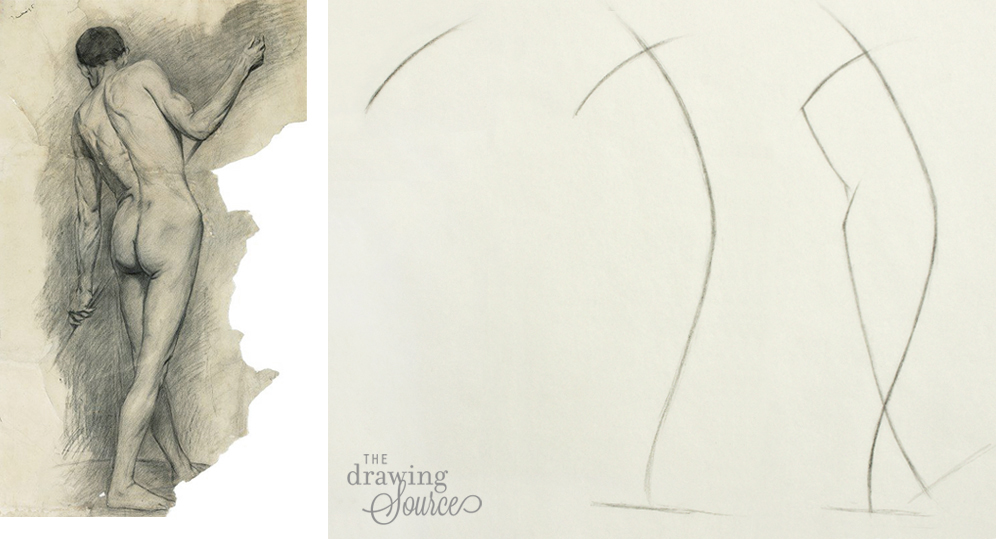
In poses where the shape of the head is partially or completely obscured and the line of the shoulders is a more prominent characteristic, the latter can exist an ideal place to begin the drawing.
How do you find the line of the shoulders?
When viewing the figure from the front, the line of the shoulders is found along the visible line created by the clavicle bones, beneath the triangular outline of the shoulders created by the trapezius muscle. Muscles prevarication on top of the skeletal structure of the body. We can mimic this order in our drawings by indicating the line of the clavicles start, and adding the trapezius muscle on top of that construction line subsequently.

When viewing the figure from the dorsum, look for the point of the shoulder where the clavicle meets the acromion process of the scapula. This is unremarkably adequately easy to locate because there is a protrusion which can often be seen on the surface of the body, right where the clavicle ends and articulates with the scapula.
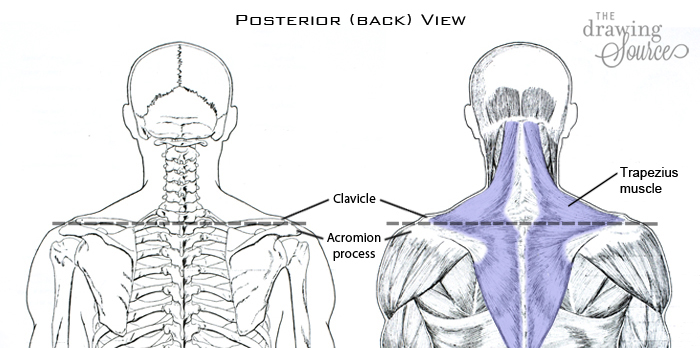
![]()
On some people, the bending of the shoulder straightens out considerably in this expanse, making the line of the shoulders easier to locate. Connect these points on both shoulders with a straight or arcing line to find the shoulder line.
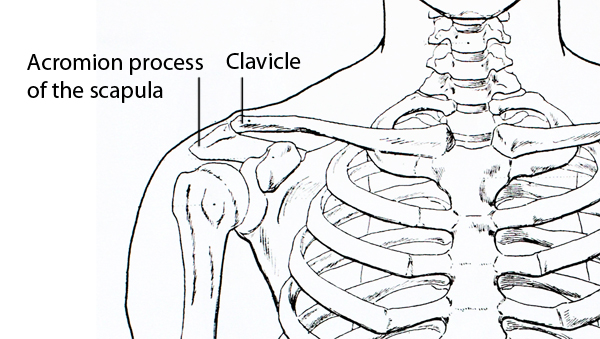
Hither is another instance of a cartoon scenario in which yous may choose to begin with the shoulders instead of the head:
 Completed drawing on the left by Nikolai Blokhin
Completed drawing on the left by Nikolai Blokhin
3. You tin begin drawing figures with a gesture line
When a pose has a very distinct, expressive movement that you want to communicate, you may choose to begin with a gestural line that describes the major action occurring in the pose. An easy way to identify this major action is to ask yourself, "What is the figure doing?" or "What is happening in this pose?"
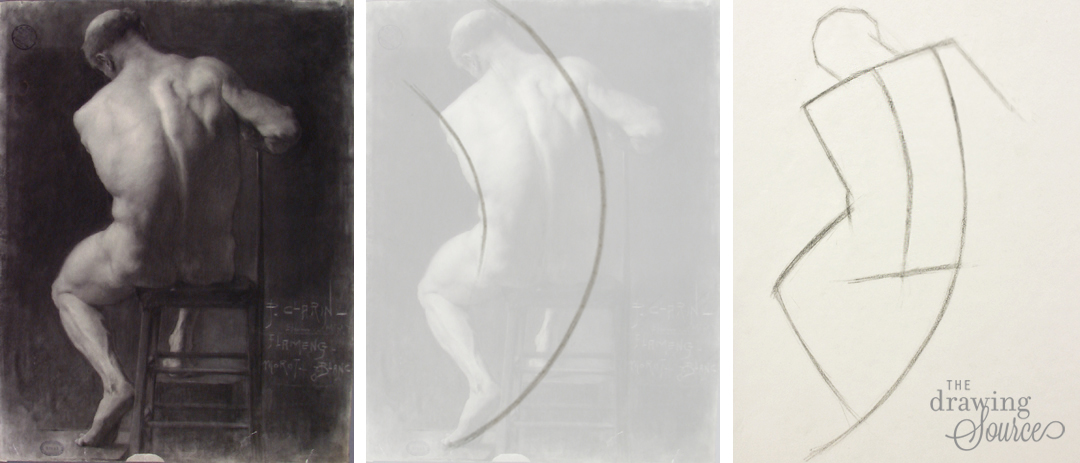 Completed drawing on the left by Paul-Louis Clarin
Completed drawing on the left by Paul-Louis Clarin
In this case the effigy is seated on a chair, leaning slightly forwards and to the left, and looking at the basis. One leg is extended frontward while one is flexed back. I can describe this movement about simply past drawing a sweeping C-curve that begins at the head, curves around the body and continues on to connect the body to the sole of the foot. Notice the repetition of this motion in the left side of the body and in the curvature of the spine.
Once I take established this movement, I can find the bending of the shoulders, the shape of the head, and where the torso ends. The arms and legs can be indicated initially with gestural lines.
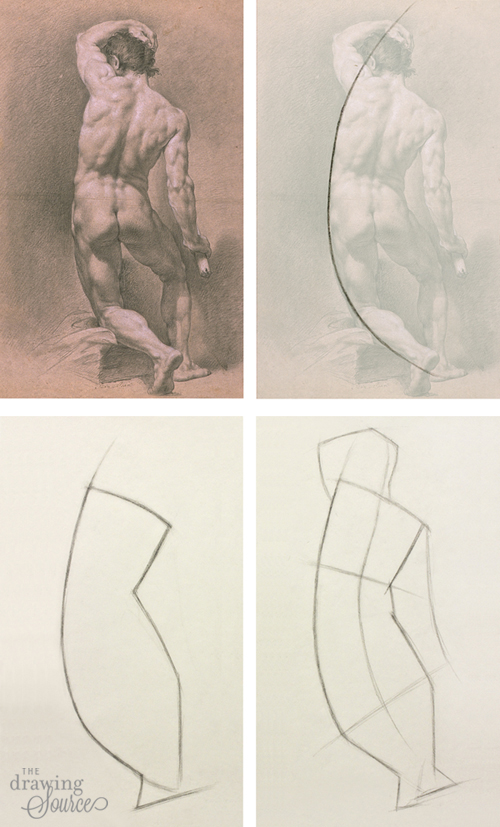 Completed cartoon on the peak left by Juan Adan Morlan
Completed cartoon on the peak left by Juan Adan Morlan
In this similar scenario, the chief action line in the above drawing is a sweeping C-curve that is repeated in the right side of the body, the spine, and even in the position of the right arm. Later drawing the overall movement of the pose with a gesture line, I move on to detect the line of the shoulders, the opposing compressed activity in the right side of the body, and the feet.
![]()
four. You can brainstorm drawing figures with a shape.
Poses that are compressed or foreshortened (for example, when the figure is seated or reclining) may not have a long, sweeping major activeness line. Instead, their gesture may be best communicated by cartoon the shape that the pose fits into.
You lot can offset these types of figure drawings by blocking in a specific shape, paying close attending to its proportions and angles (the triangle below is not an equilateral one!). Then, imagine that you are a sculptor chiseling away backlog areas of the triangle to reveal the class of the figure.
 Completed drawing on the left past Anthony van Dyck
Completed drawing on the left past Anthony van Dyck
![]()
5. You tin begin drawing figures with an "envelope".
Every bit the title of this strategy suggests, an "envelope" envelops the pose. I use the envelope when drawing a challenging pose that I desire to brainstorm more analytically rather than intuitively, in order to increase my chances of drawing information technology accurately. Similar to the higher up shape method, the envelope shows the states the surface area that the figure occupies. To depict the envelope you can use straight lines, curved lines, or a combination of the ii to map out the boundaries of the figure.
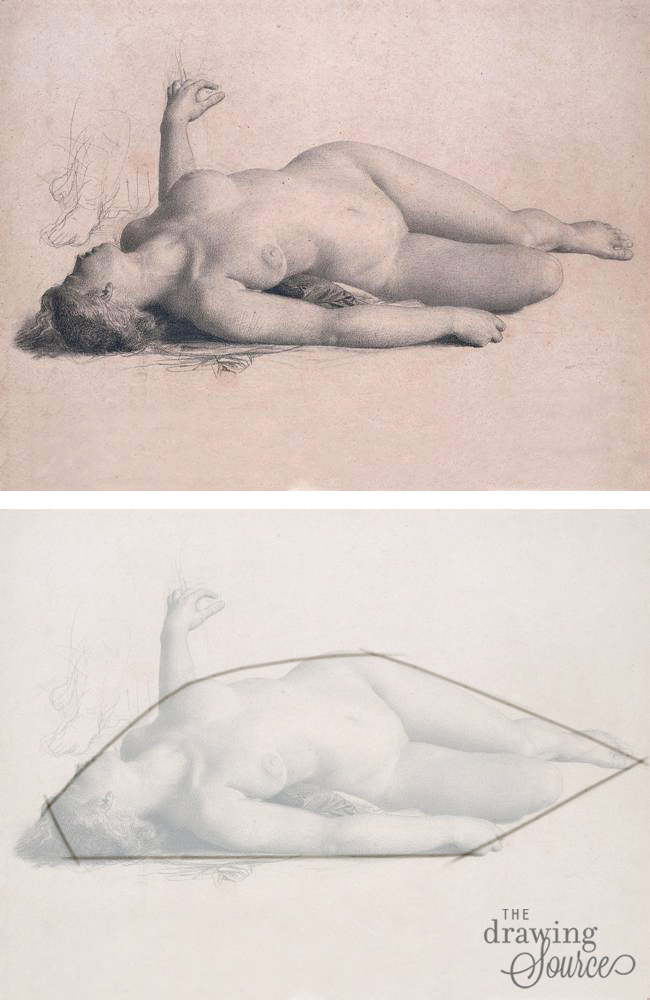 Completed drawing by Charles Gleyre
Completed drawing by Charles Gleyre
Notice that a new line begins wherever there is a major angle change in the pose.
 Completed drawing on the left past Kenyon Cox
Completed drawing on the left past Kenyon Cox
Are yous starting to find any patterns? No affair how I begin my drawing, the essential information that I effort to find every bit quickly equally possible in my offset ten or and then lines is:
![]()
the general shape and tilt of the head
![]()
the line of the shoulders
![]()
the primary action line and gesture of the pose
![]()
the placement of the feet
![]()
the approximate elevation and width of the pose
Taking your time to observe and draw these elements will create a successful foundation for the residual of your block in, the construction of the figure, and the eventual rendering of the cartoon.
![]()
Download a PDF version of this article!
(plus, get a weekly newsletter and access the Members-Only Cartoon Resource Library)!
![]()
Drawing Figures: Choosing a Strategy
If you're having difficulty deciding which strategies to use to brainstorm drawing figures, here are a few things to consider:
Brainstorm with what inspires you.
What you lot brainstorm with depends on what is well-nigh important to y'all in the pose. Before you lot fifty-fifty selection up your pencil, start identify what interests you: Why practice yous desire to draw this pose? What is it that inspires you lot about this particular pose that you wish to communicate in your drawing? If it is the dynamic movement, for instance, and then perhaps brainstorm with a gesture line to express that idea with your initial pencil marks.
Offset with the easiest, almost evident variable.
You can also brainstorm with whichever variable is virtually evident to you. Which element from the above list of "must-haves" do you recollect volition be easiest to describe accurately? If the shape and tilt of the head seem clear and obvious to you, for example, begin in that location. Mayhap it is the singled-out angle of the shoulders that stands out to yous.
With practice, determining how to begin your cartoon will become a artistic and exploratory try.
Happy Drawing,
![]()
![]()
Enjoyed this page? Please share it!
Share buttons and pinnable images below:
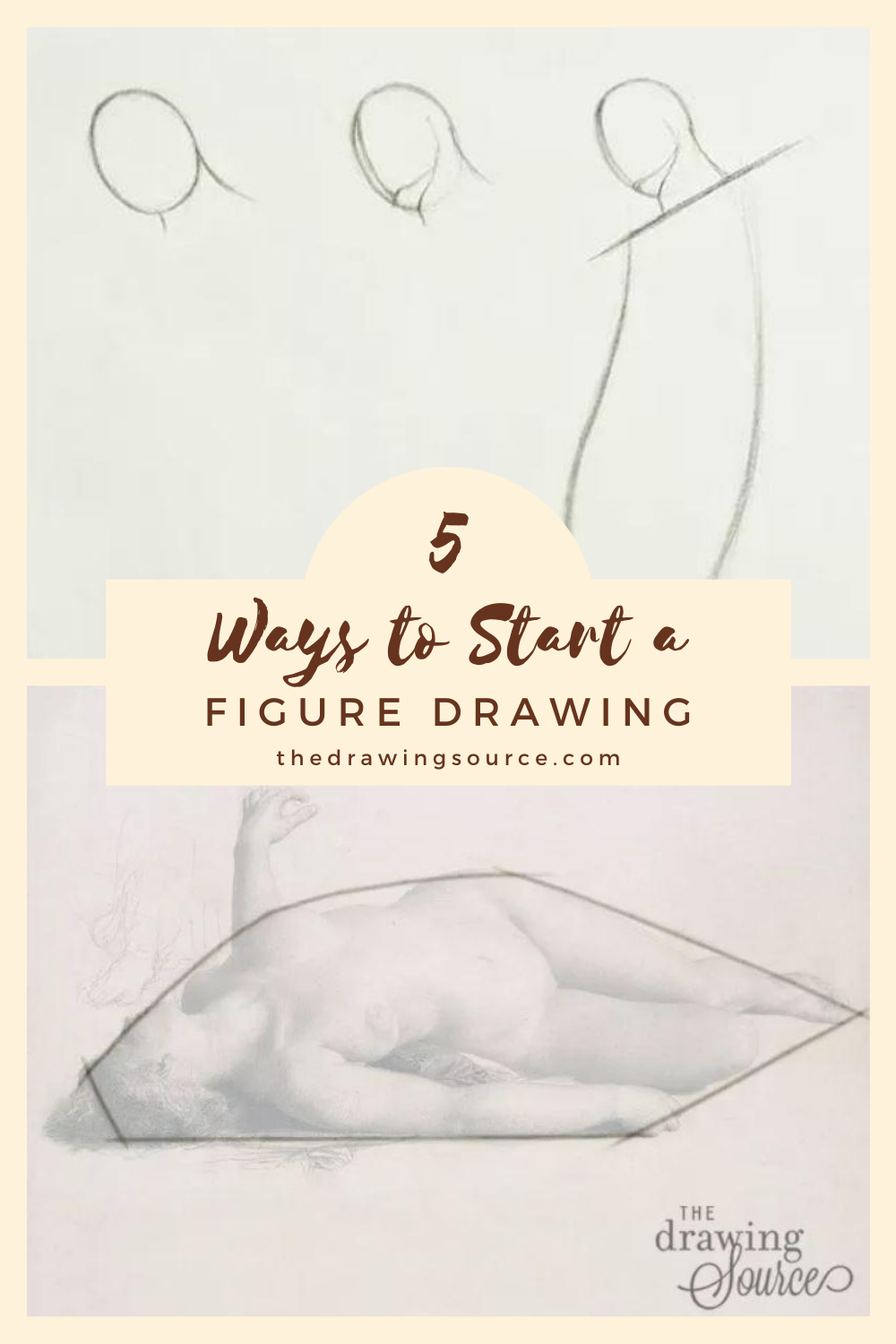

If you enjoyed this page on drawing figures,
y'all may likewise be interested in ...
Return to Figure Drawing from 5 Ways to Commencement Drawing Figures
Render to the Homepage from 5 Ways to Beginning Drawing Figures
![]()
Source: https://www.thedrawingsource.com/drawing-figures.html
Posted by: wyattparge1941.blogspot.com


0 Response to "How To Draw Simple Human Figures"
Post a Comment